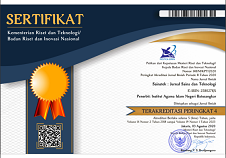Characterization and Analysis of Activated Carbon from Coconut Shells Applied to Supercapacitors
Abstract
Activated carbon is used materials as an electrode for supercapacitors. The aim of this research is to characterize and analyze activated carbon for results with high specific surface area, chemical resistance, electrical conductivity, and affordability. The pyrolysis technique is used in the activation process to remove water content and achieve optimal carbonization at an activation temperature of 600°C. For chemical activation, the carbon is immersed in 10% KOH and 10% Na2CO3 activating agents. The X-RD results in crystalline phases of graphite at peaks 25° and 44°, showing diffraction peaks of carbon and graphite. SEM characterization microstructure morphology at 3000 times magnification, with a 10 µm image size, the formation of porosity that carbon activation. The iodine adsorption measurement KOH-activated carbon sample is 630.70 mg/g, and Na2CO3 activation at 567.89 mg/g. Conductivity measurement results indicate that the conductivity values of activated carbon with the addition of KOH and Na2CO3 activation, measuring 1724.10 S/m and 1660.60 S/m.
Keywords
Full Text:
PDFReferences
Abioye, A. M., & Ani, F. N. (2020). High Performance Supercapacitor Based on Activated Carbon Electrodes Prepared Using Microwave Temperature as Process Parameter. 198(Issat), 90–95. https://doi.org/10.2991/aer.k.201221.017
Ahmad, A., Gondal, M. A., Hassan, M., Iqbal, R., Ullah, S., Alzahrani, A. S., Memon, W. A., Mabood, F., & Melhi, S. (2023). Preparation and Characterization of Physically Activated Carbon and Its Energetic Application for All-Solid-State Supercapacitors: A Case Study. ACS Omega, 8(24), 21653–21663. https://doi.org/10.1021/acsomega.3c01065
Ahmed, S., Ahmed, A., & Rafat, M. (2018). Supercapacitor performance of activated carbon derived from rotten carrot in aqueous, organic and ionic liquid based electrolytes. Journal of Saudi Chemical Society, 22(8), 993–1002. https://doi.org/10.1016/j.jscs.2018.03.002
Bakti, A. I., & Gareso, P. L. (2018). Characterization of Active Carbon Prepared from Coconuts Shells using FTIR, XRD and SEM Techniques. Jurnal Ilmiah Pendidikan Fisika Al-Biruni, 7(1), 33–39. https://doi.org/10.24042/jipfalbiruni.v7i1.2459
Bakti, A. I., Gareso, P. L., & Rauf, N. (2018). Characterization of Active Carbon from Coconut Shell using X-Ray Diffraction (X-RD) and SEM-EDX Techniques. Jurnal Penelitian Fisika Dan Aplikasinya (JPFA), 8(2), 115. https://doi.org/10.26740/jpfa.v8n2.p115-122
Gautham Prasad, G., Shetty, N., Thakur, S., Rakshitha, & Bommegowda, K. B. (2019). Supercapacitor technology and its applications: A review. IOP Conference Series: Materials Science and Engineering, 561(1). https://doi.org/10.1088/1757-899X/561/1/012105
Hidayu, A. R., Mohamad, N. F., Matali, S., & Sharifah, A. S. A. K. (2013). Characterization of activated carbon prepared from oil palm empty fruit bunch using BET and FT-IR techniques. Procedia Engineering, 68, 379–384. https://doi.org/10.1016/j.proeng.2013.12.195
Hidayu, A. R., & Muda, N. (2016). Preparation and Characterization of Impregnated Activated Carbon from Palm Kernel Shell and Coconut Shell for CO2 Capture. Procedia Engineering, 148, 106–113. https://doi.org/10.1016/j.proeng.2016.06.463
Kushwaha, S., Sreelatha, G., & Padmaja, P. (2013). Physical and chemical modified forms of palm shell: Preparation, characterization and preliminary assessment as adsorbents. Journal of Porous Materials, 20(1), 21–36. https://doi.org/10.1007/s10934-012-9571-4
Nuradi, R. F., Muldarisnur, M., & Yetri, Y. (2022). Synthesis of Supercapacitor from Cocoa Fruit Peel Activated Carbon for Energy Storage. Jurnal Ilmu Fisika | Universitas Andalas, 14(2), 86–94. https://doi.org/10.25077/jif.14.2.86-94.2022
Pradhan, S. (2011). Production and characterization of Activated Carbon produced from a suitable Industrial sludge. 60.
Rani, N. H. A., Mohamad, N. F., Matali, S., & Sharifah Aishah, S. A. S. (2014). Preparation and characterization of activated carbon made from oil palm empty fruit bunch. Key Engineering Materials, 594–595, 44–48. https://doi.org/10.4028/www.scientific.net/KEM.594-595.44
Rustamaji, H., Prakoso, T., Devianto, H., Widiatmoko, P., & Nurdin, I. (2022). Optimization of Electrode Material Composition from Activated Carbon, MWCNT & Graphene to Enhance Performance of Supercapacitor. Journal of Engineering and Technological Sciences, 54(5). https://doi.org/10.5614/j.eng.technol.sci.2022.54.5.5
Taer, E., Sihombing, M., Taslim, R., Agustino, & Apriwandi. (2020). Bamboo-Based Activated Carbon as Binder-Free Electrode of Supercapacitor Application. Journal of Physics: Conference Series, 1655(1). https://doi.org/10.1088/1742-6596/1655/1/012163
Tumimomor, F. R., & Palilingan, S. C. (2018). Pemanfaatan karbon aktif dari sabut kelapa sebagai elektroda superkapasitor. Fullerene Journal of Chemistry, 3(1), 13. https://doi.org/10.37033/fjc.v3i1.29
Xiong, C., Wang, N., & Feng, M. (2023). Activated Carbon Derived from Waste Oil Shale Semi-Coke for Supercapacitor Application. Molecules, 28(12). https://doi.org/10.3390/molecules28124804
DOI: http://dx.doi.org/10.31958/js.v15i2.10605
Refbacks
- There are currently no refbacks.
Copyright (c) 2023 Andi Ikhtiar Bakti, Handy Indra Regain Mosey, Jumriadi

This work is licensed under a Creative Commons Attribution-NonCommercial-NoDerivatives 4.0 International License.
Indexed by:
__________________________________________________________________________
Sainstek: Jurnal Sains dan Teknologi
ISSN 2085-8019 (print) | 2580-278x (online)
Published by Institut Agama Islam Negeri Batusangkar
Email: sainstek@iainbatusangkar.ac.id
This work is licensed under a Creative Commons Attribution-NonCommercial-NoDerivatives 4.0 International License.















